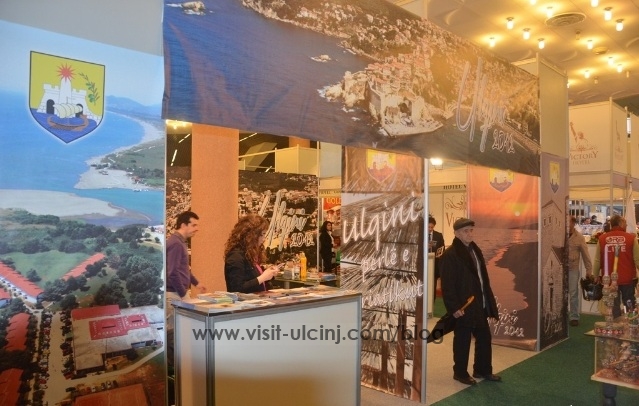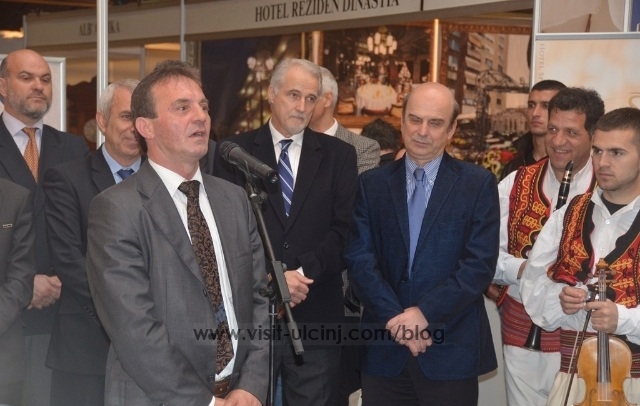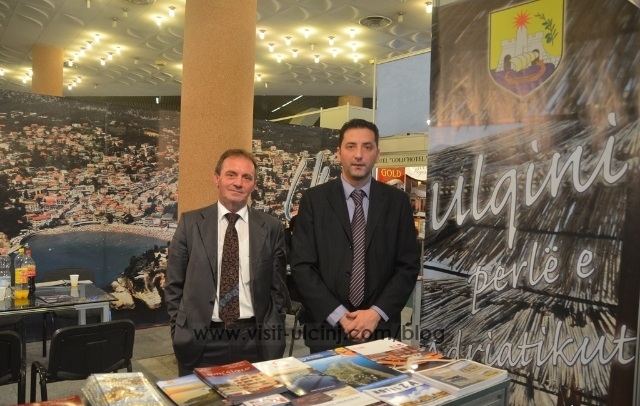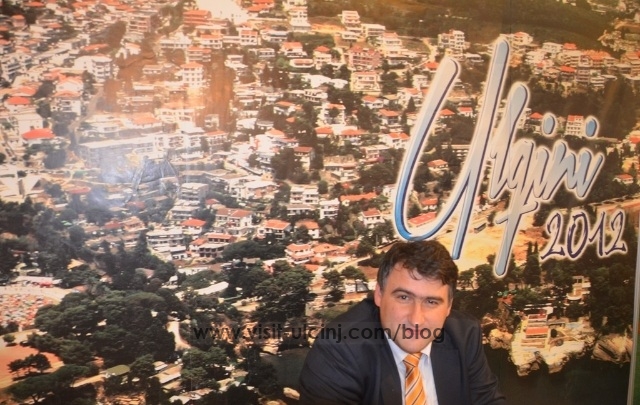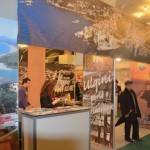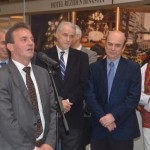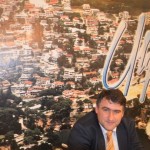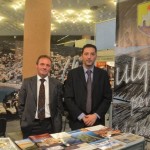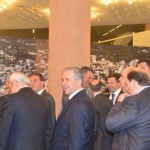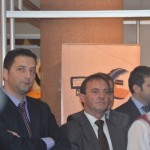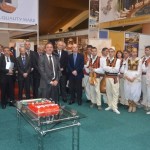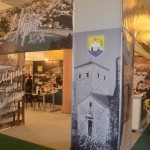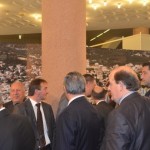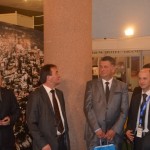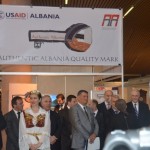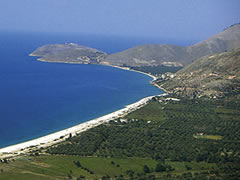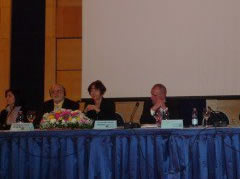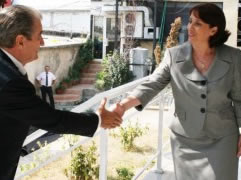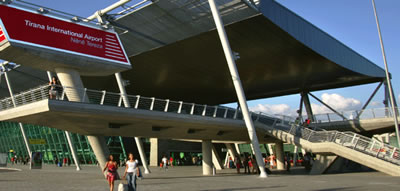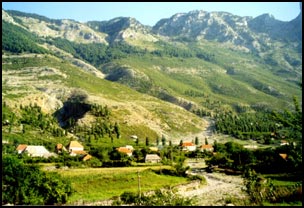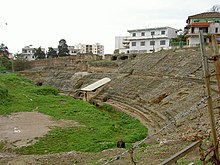 Berat
Berat, the Town of a Thousand and One Windows.

Castle of
Kruja, site of the Skanderbeg Museum

Korçë, the city of Serenades.

Taivani, the most popular restaurant of the vibrant capital Tirana as seen from the Sky Tower Revolving Restaurant

Traditional village of
Dhermi along the Albanian Riviera
Tourism in Albania is characterized by the archaeological heritage from
Greek,
Roman and
Ottoman times,
unspoiled beaches,
mountainous topography, delicious traditional
Albanian cuisine,
Cold War era artifacts,
unique traditions and hospitality, and the wild and
peculiar atmosphere of the countryside.
Although still underdeveloped, tourism has seen an impressive increase
in recent years. Lonely Planet ranked Albania as the no. 1 destination
to be visited in 2011.
[1] Albania was ranked fourth in MSN Travel's 2012 Hottest Destinations.
[2]
In addition, Albania was chosen as one of the top destinations for
British tourists travelling during the 2012 Queen's Diamond Jubilee.
[3] In August 2011, American actress with Albanian origin
Eliza Dushku
visited Albania to film a promotional documentary on her father's
country of origin with a crew from the Travel Channel and Lonely Planet.
[4][5][6] In fact, a watershed moment in tourism promotion was the publication of promotional videos on major global news channels.
The bulk of tourists coming to Albania is made up of
Albanians coming from Albania,
Kosovo,
Macedonia, and
expats from Greece, and Italy.
[7][8]
These prefer mostly beach tourism, while rural tourism is slowly
gaining popularity. Foreign tourists mostly come from Eastern Europe,
particularly from
Poland, and the
Czech Republic, and also from Western Europe such as
Germany,
Italy,
France, and Scandinavian countries.
[9] They tend to visit alpine settings though beach tourism is also practiced.
Backpackers
are common and prefer resting at the many hostels in Tirana, or camping
in the countryside or along the coast. Organized groups mainly visit
the numerous archaeological sites and historic towns. A growing trend
has become rafting in the many canions, cycling, hiking in the
mountains, or cross-country off-road touring in the countryside. The
latter can also be explored through the adventurous
Albanian railway system. Recently, car rental agencies and information centers have opened branches in
Tirana International Airport,
in the capital and other towns. Dental tourism has become popular as
local dentists offer Western standards with much lower prices. Local
delicious cuisine can be tasted at traditional Albanian restaurants
located near tourist attractions and scenic spots throughout the
country.
However, tourism is hampered by local management issues such as poor
road and public utilities infrastructure, unregulated waste disposal,
illegal construction and hunting, uncertain land ownership, and an
unqualified hospitality sector. Recently, some coastal, and mountainous
roads have been reconstructed, while the local private sector and
foreign donors are heavily investing in accommodation and renovations at
historical sites. Albania has been dubbed the "New Mediterranean Love".
[10]
Entry requirements
Citizens of the following countries do not require visas to enter:
All 27 EU members, Andorra, Argentina, Australia, Brazil, Canada, Chili,
Croatia, Vatican, Iceland, Israel, Japan, Kosovo, Liechtenstein,
Macedonia, Malaysia, Monaco, Montenegro, New Zealand, Norway, Russia,
San Marino, Serbia, Singapore, South Korea, Switzerland, Taiwan, Turkey,
United States of America, and Ukraine.
[11]
History
Albania has been visited by a number of important
chroniclers, including
Evliya Çelebi,
Lord Byron,
Edith Durham,
Rose Wilder Lane, and
Edward Lear.
[12][13][14][15] Tourism in Albania was officially established with the creation of the Royal Motor Tourist Club serving business travelers in
King Zogs era. At the same time, the period saw the publication of promotional pamphlets and the construction of beach cabins in
Durres by Italian engineers. Following the establishment of
communism in 1945, foreign tourists came only from the
Eastern block and were accommodated at the foreigners-only Adriatik Hotel in
Durres. Following the break with the
USSR, the regime encouraged
Chinese
tourists to visit Albania. Afterwards, foreign tourism was outlawed and
all foreign tourists were banned from entering Albania. However in the
1980s, Western tourists were allowed to visit Albania as part of
Marxist-Leninist
organizations and were allowed to only visit historic sites. Upon
arrival, some of them underwent shaving by local authorities. In fact,
beards and long hair in men were banned in Albania as signs of
degenerated bourgeoisie manners.
[16]
With a growing and stable working class, the state allowed the
construction of additional hotels and beach cabinbs in tourist areas. By
communist law, all Albanians were allowed to rest for 15 days per annum
at the state owned Rest Houses (Shtepi Pushimi) usually located along
the seaside. Every year, Albanians had to choose between going to the
seaside or the mountain areas interchangeably. Holidays were very cheap
as expenses only equalled 1/5 of the monthly salary. The latter rested
at heavily guarded secluded areas mainly in Golem Beach south of Durres,
Drilon Swans Park east of
Pogradec, in village areas, and along the
Albanian Riviera.
Youth camps were also established and a tourist boat called Punetori
(the Worker) was constructed. The population used heavily rail transport
as private car ownership was forbidden by law.
Since the fall of communism, visiting restrictions greatly eased
while the tourism sector experienced a spontaneous and uncontrolled
construction spree. The
1997 unrest
was a major blow as it contributed to the negative image of Albania as a
lawless and unsafe country. In the 2000s, important roadways were
reconstructed while illegal/spontaneous construction continued in some
popular areas. Lately, domestic tourists and businessmen have started to
rediscover forgotten parts of Albania. A significant watershed moment
for the redevelopment of tourism was the publication of several
promotional videos on major global news channels
[17] and the writing of promotional articles in important international newspapers.
[18] In 2010, tourism in Albania had the greatest increase in the world with a 42% growth.
[19]
Significant progress is being made particularly in
ecotourism.
Coastal-bound roads have been reconstructed, while private businesses
have heavily invested in acceptable accommodation and in keeping clean
the surrounding environment. A successful example of a private sector
initiative is the 40 Guesthouses Initiative in the Albanian Alps. Locals
with aid from foreign donors have organized in turning their inns into
accommodation enmities for ecotourism.
[20]
Once a deprived area, it became a leading part of a self sustainable
project providing much needed income to locals. As part of UNESCO
membership, Albanian sites are being awarded funds for the
reconstruction of important landmarks. The World Bank and other donors
finance regional master plans and public utilities infrastructure
projects. In the professionalism aspect, the European University for
Tourism (EUFT)
[21] opened in Tirana to better train hospitality sector personnel. International hotel chains are established in
Tirana, while trans-border travel agencies organize day trips from
Corfu to
Sarandë and nearby
Butrint. Other tour operators are including Albania as part of their Balkan region packages.
Club Med has proposed a development between
Vlorë and Sarandë at Kakome Bay.
[8]
Destinations
Towns and archaeological sites
Stemming from a rich history of conquests, Albania holds a mix of interesting artifacts. The most visited towns are:
- A thousand and one window town of Berat
- Old port city of Durrës (Dyrrhachium)
- Stone city of Gjirokastër
- Krujë, the balcony over the Adriatic sea
- Shkodër, the city that is home, among others to the Rozafa Castle
- Tirana, the capital with a vibrant nightlife
- Beach city of Vlorë (the city of olives and grapes)
- Lezha, the historic diplomatic capital of Albania
- Poet's city of Pogradec
- Honeymooners' city of Sarandë
- Year round festive city of Korcë
The most visited archaeological sites are
Natural attractions
Albania is known for its breathtaking landscape. Some increasingly popular features include:
Village areas
Albania is a rural and agricultural oriented country. The main emerging
agritourism destinations are:
Panoramic routes
Due to the varying geographic elevation, Albania features endless panoramic routes with the main being:
 Vlora-Saranda route in Southwestern Albania along the Albanian Riviera
starting from coastal Vlore into Llogara Pass and along the Ceraunian Mountains
Vlora-Saranda route in Southwestern Albania along the Albanian Riviera
starting from coastal Vlore into Llogara Pass and along the Ceraunian Mountains Rreshen-Kalimash motorway along the Fan River Valley in Northern Albania
Rreshen-Kalimash motorway along the Fan River Valley in Northern Albania- SH83 Jergucat-Delvine route overlooking the Dropulli Plain in Southern Albania
 Elbasan-Pogradec route along the Shkumbin River valley and Ohrid Lake
Elbasan-Pogradec route along the Shkumbin River valley and Ohrid Lake- Koplik-Theth and Koplik-Vermosh in the Albanian Alps overlooking steep cliffs, challenging mountain peaks, and crystal clear rivers and waterfalls
Festivals and national heritage
The Albanian culture is known for its rich folklore and unique traditions showcased in various forms:
- Gjirokaster National Folklore Festival is held every 5 years in Gjirokaster (last held in September 2009)
- Lock-in Tower of Theth as an artifact of the bloodfeud tradition
- National Historic Museum in Tirana, Skanderbeg Museum in Kruja, Skanderbeg's Tomb in Lezha, and the many Ethnographic Museums scattered in various cities
- Albanian traditional wedding celebrations mostly take place in the
summer time and can be observed at historic sites as well. Moreover,
some conservative older men and women mainly from the North still wear traditional clothing in their daily lives. Instead, older women from the South usually wear all black outfits.
- Evening walkabouts are a traditional ritual usually in the summer
months as locals promenade along the town squares or seaside promenades
to relax after tiring hot summer days. Cafes are usually full mainly
with retirees and students, while local parks with families. In
addition, Tirana enjoys a very active nightlife where luxury cars and charming women invade the streets and bars of the former politburo residence area known as Blloku. The afternoon Siesta is observed as some shops close down for a few hours after midday.
- There is a strict code of conduct when meeting with Albanians.[23]
- Throughout the year, many regions organize local exhibitions and festivals of regional crafts and delicacies.
UNESCO World Heritage Sites
Albania is home to three World Heritage Sites:
Issues affecting tourism
The main problem to a viable tourism industry is the lack of a clear
strategy. By far, tourism is not seen as the main economic industry of
the country. Some problematic issues include spatial planning such as
illegal construction, unregulated waste disposal, poor road and
utilities infrastructure, illegal logging and hunting, and unclear land
ownership. On the education aspect, there lacks a clear accommodation
classification system and qualified hospitality personnel. The private
sector has taken some tasks from the local government as the latter has
proven ineffective in tackling most of the above problems, while foreign
institutions are financing public infrastructure and town planning
projects.
Construction, infrastructure, and waste management
Illegal construction is ruining some popular areas
[24] while poor road and public utilities'
infrastructure greatly hamper tourism. Electrical
power outages
are still common, while water supply in some areas is intermittent. New
water supply systems are being constructed at tourist areas through
money financed by foreign banks. The consumption of bottled water
instead of tap water is recommended. In recent years, most main roads
have been undergoing reconstruction thus further adding to delays but
greatly improving the road system. Independent bus and minibus (furgon)
operators provide inexpensive transport between most large communities,
but schedules and prices are not fixed. Train service is also limited
and sporadic.
Uncontrolled waste disposal is a problem mostly visible along major
roadways and some coastal stretches in the countryside, as waste is
burned into the atmosphere or dumped along major rivers to return back
to the coast.
[25] Volunteers' groups have taken the initiative to clean the affected areas as local authorities are ineffective and powerless.
[26] A number of landfills have been constructed recently while some towns have started to implement recycling programs.
[27] The production of cement and
lime takes place near the touristic town of Kruja, while
air pollution
from car exhaust mostly affects Tirana. Furthermore, illegal hunting in
the country's many lagoons has dramatically reduced rare bird species.
Mosquito disinfection campaigns along former swamps have long been
halted.
Even though 70% of the country is mountainous, Albania is the only
country in Europe where ski lifts and mountain rescue structures do not
exist. However, a local
ski resort opened recently the first
ski tow
in Albania. International beach resort chains are not present in the
country as of yet, though some have expressed interest while others,
like Lalzit Bay Resort and Spa have begun construction work along the
Adriatic coast north of Durres.
Since 2006, the
Albanian government
has imposed a moratorium on all domestically owned, motor-powered boats
on all Albanian lakes, rivers, and seas to curb organized crime.
[28] This has acted as a halting factor to the domestic sailing and tourism industry.
[29] However, foreign and government owned boats, fishing boats, and
jet boats are exempted from the moratorium. For sailing information, visit.
[30]
See also
References
- ^ 400,000
More Tourists Visited Albania in 2008 "From BalkanTravellers.com
http://www.suite101.com/content/lonely-planet-albania---in-from-the-cold-in-2011-a303777". BalkanTravellers.
- ^ http://travel.ca.msn.com/travel-trends-2012s-hottest-destinations#image=5
- ^ http://www.travelbite.co.uk/travel-news/2012/03/05/great-escape-brits-going-abroad-for-diamond-jubilee
- ^ "Why You Must Visit Albania". Huffington Post. September 2, 2011. Retrieved March 11, 2012.
- ^ http://news.bostonherald.com/track/star_tracks/view/2011_0808inside_track_headline_2/srvc=home&position=also
- ^ "Eliza Dushku në Tiranë, promovon vlerat turistike të Shqipërisë". Koha.net. August 6, 2011. Retrieved August 7, 2011.
- ^ 23% Increase of Tourists to Albania in 2008 – Fresh Property Co.
- ^ a b http://www.kategora.com/en/albania-news--75.html
- ^ Turizmi ne Shqiperi: Reklama per Evropen Lindore, Shqiperia.com
- ^ ALBANIE 2009 LE PETIT FUTE By AL. DOMINIQUE page 7
- ^ "INFO FOR FOREIGNERS / Who enter Albania without a visa". Republic of Albania Ministry of Foreign Affairs.
- ^ http://www.thelongridersguild.com/Byron.htm
- ^ http://www.illyrians.org/edurham.html
- ^ http://books.google.ca/books?id=5q5BAAAAYAAJ&source=gbs_book_other_versions
- ^ http://books.google.ca/books?id=hj8tAQAAIAAJ&q=edward+lear+albania&dq=edward+lear+albania&hl=en&ei=743aTtX5IqHl0QG77N3JDQ&sa=X&oi=book_result&ct=result&resnum=2&ved=0CDgQ6AEwAQ
- ^ http://www.telegraph.co.uk/travel/destinations/europe/albania/7867628/Regent-Holidays-celebrates-40-years-in-Eastern-Europe.html
- ^ http://www.youtube.com/watch?v=CB-Z6AlT1AQ&NR=1
- ^ http://www.mtkrs.gov.al/web/Media_e_Huaj_mbi_Turizmin_Shqiptar_633_1.php
- ^ Wall Street Journal: The $800 Billion mistake Topics
- ^ Thethi, eternal love of tourists and sportsmens – Theti-Guide
- ^ EUFT
- ^ Tourist Attractions in Albania – VirtualTourist
- ^ http://www.balkanology.com/albania/article_albania_for_beginners.html
- ^ http://iwpr.net/report-news/albania-pollution-keeps-tourists-away
- ^ Trash, sewage mar Albania tourism, investment lure – Reuters
- ^ European Communities, Commission of. 2009. Albania 2009 Progress Report. Brussels: European Commission.
- ^ European Bank for Reconstruction and Development. 2009. Strategy for Albania: 2009-2012. European Bank for Reconstruction and Development.
- ^ Council of Ministers of the Republic of Albania, www.keshilliministrave.al, 10 August 2006.
- ^ Mit ‘moratorium albanien sport boote skaf’ getaggte Artikel
- ^ Noonsite: Albania
Further reading
- Inter Press Service. Unknown Albania - A Case Study. UNDP Albania: Tirana, 2007
- Gorica, Klodiana. 2005. Albanian Tourism Management: The Future Path to Sustainable Development, Amfiteatru Economic 7, no. 18: 104-112
- Gorica,
Klodiana. Issues of European Integration for Tourism: Challenges of
Albania as an Emerge Destination. University of Tirana
- Kruja, Drita and Albana Gjyrezi. 2011. The Special Interest Tourism: Development and the Small Regions, Turizam 15, no. 2: 77-89
- Kushi, Evis and Enkela Caca. 2010. Some Problems of the Micro, Small and Medium Enterprises in Albanian Holiday Hotels, Regional Science Inquiry Journal 1, no. 2: 63-70
External links
Official Regional Travel Guides







